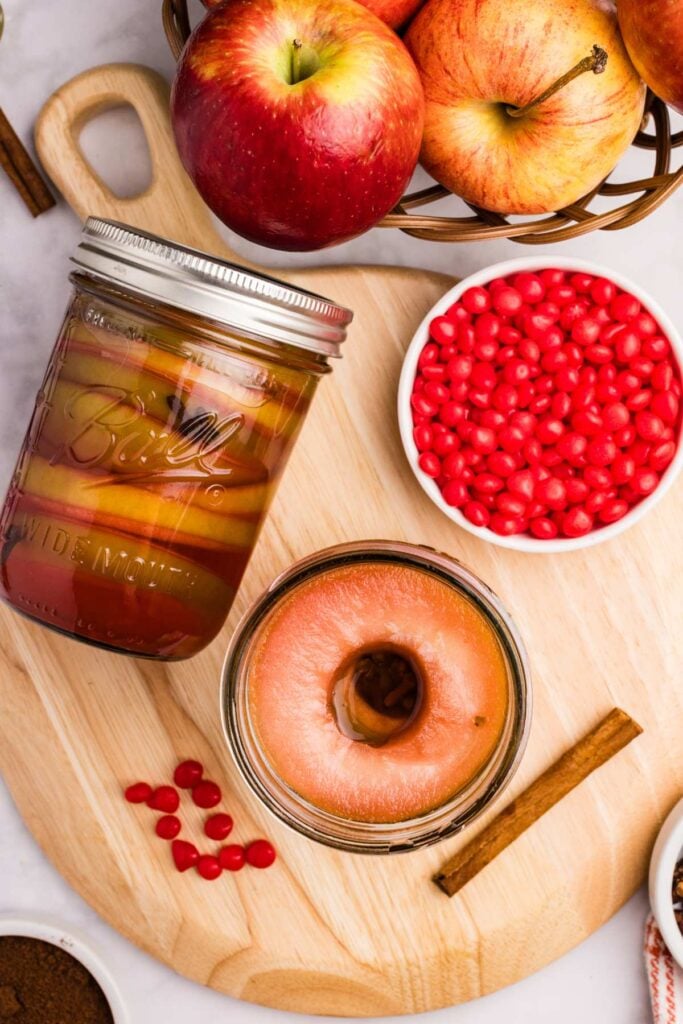Inside: how to raise baby chicks from tiny newborns to awkward feathered teenagers. We’ll get you all set for a happy, healthy flock.
They’re fluffy and adorable, and they make the cutest sounds. They’re also messy, stinky, and require a lot of care. Raising chicks isn’t exactly hard, but it’s a lot of work. If you’re ready for the challenge, you’ll add fun and excitement to your house and be proud that you started your own flock. It’s worth the work, and one of the most rewarding parts of raising chickens. Here’s how to do it.

What to Do Before Your Chicks Hatch or Arrive
Make sure you have all the ready to go before your chicks arrive! They will be needed the minute you get them. If you’re hatching your own chicks, start prepping your brooder on day 18. If you’ve ordered chicks, make sure you are ready a full week before they arrive
What You Need to Set Up the Brooder

- Plastic Bin: A 20-gallon bin provides enough space for the first week or two. Make sure it’s clean and free of cracks.
- Heat Lamp: Choose a low-heat/low-wattage option, equivalent to about a 75-watt incandescent bulb. Ensure the chicks have space to move away from the heat if needed.
- Thermometer: This is essential! Monitor temperatures in the bin to ensure it’s the right warmth for the chicks’ age.
- Bedding: I recommend using bedding that is 100% natural and easily accessible. Chicks grow quickly, and they eat more and more, which means they poop more and more! Having a lot of extra bedding readily available is very important for keeping the chicks clean. Pine shavings are popular, but if you live nearby a lot of pine trees, consider using dry pine needles. It’s free! I also highly recommend pine shavings because pine is excellent for masking their odor. I use pine shavings in their coop until they are fully grown.
- Cage or Chicken Tractor: This provides a safe space for chicks during bin cleaning or outdoor playtime.
Feeding and Watering Supplies You’ll Need

- Water Source: Chicken nipples attached to a cleaned jar prevent chicks from getting wet or drowning.
- Chick Feed: For feed, I recommend using a starter that is medicated and has a minimum crude protein of about 18%. If you head to your local animal feed store and ask for chick starter feed, they will help you find the best fit for your needs. (You can feed them this starter feed until the hens lay their first eggs. At that point, I recommend swapping them over to a mix of layer pellets and 5-way scratch so that they have the nutrients they need to make healthy eggs.)
- Round Chick Feeder: Secure it to a piece of wood to prevent chicks from knocking it over.
How to Set Up the Brooder
Before your chicks arrive, take these steps to set up the perfect environment. We’re just assembling everything here.

- Set up the Brooder: Choose a draft-free location for your plastic bin. Add a generous layer of fresh bedding (pine needles or shavings).
- Install the Heat Lamp: Secure the heat lamp above the bin, ensuring there’s space where the chicks can move away from direct heat if they get too warm. Place your thermometer directly under the lamp.
- Check the Temperature: With the heat lamp on, adjust its height until the thermometer reads 95 degrees Fahrenheit. Double-check this temperature frequently during the chicks’ first week.
- Stock up on Supplies: Have extra bedding, chick feed, and clean water ready. Remember, healthy chicks require frequent cleaning and plenty of food!
Baby Chicks Week by Week
We’ll dive deeper into each of these stages, but here’s a quick overview of what to expect at each week.

| Week | Key Developments | Notes |
| Week 1 | Chicks are very fragile and rely on the heat lamp | Provide chick starter feed, fresh water, monitor temperature closely |
| Week 2 | Chicks start developing feathers | Continue with chick starter, change bedding daily |
| Week 3 | Increased activity, may start brief outdoor play | Supervise outdoor time, watch for signs of being too hot/cold |
| Week 4 | More playful, can spend longer outdoors | Continue to provide chick starter |
| Week 5 | Rapid feather growth, less reliant on the lamp | No longer cute! |
| Week 6 | Fully feathered, ready for full-time coop life | Transitioning to coop may require patience and supervision |
Weeks 1 + 2: Staying Warm + Getting Settled
Warmth is crucial at this stage. Remember, a chick would typically be huddled under its mother for warmth. Until their feathers come in , they can’t stay warm on their own and they fully rely on the heat lamp. Chicks are fragile during these early weeks.
How to Keep Your Chicks Warm
You’ll need to check the temperature of the brooder and observe the chick’s behavior. If they are huddled together under lamp, they’re too cold. If they’re far away from the lamp constantly, they might be too warm.

Ideal temperatures for your brooder
The whole bin does not need to be 95 degrees F… just under the heat lamp.
| Hatch day through their first week of life | 95 degrees F |
| 1 week old | 90 degrees F |
| 2 weeks old | 85 degrees F |
| 3 weeks old | 80 degrees F |
| 4 weeks old | 75 degrees F |
| 5 weeks old | 70 degrees F |
| 6 weeks old | 65 degrees F |
| 7 weeks old | 60 degrees F |
Feeding Chicks
Over the years, we have learned that it is best to keep the feed in the bin in unlimited supply for the first two weeks. Though they need to have unlimited access, I highly recommend keeping the food level LOW in their feeder so that they do not scratch it all out as they grow.

It is natural for chickens to scratch as they forage for food, so they will scratch a lot of their feed out into the bedding if they can reach it with their feet. The feed will become lost in the bedding, wet, or dirty, and then wasted.
For this reason, I like to keep their feed low even if it means that I need to refill it more often.
Water Options for Chicks
You have a few choices here: a special plastic chick waterer, a waterer that screws into a mason jar, or our favorite method, described below:
DIY Chick Waterer: Gently drill a hole that is slightly smaller than the chicken nipple threading into an empty, thoroughly cleaned peanut butter jar. The size drill bit we use is 5/16”, and this works well because the fit is nice and snug.

We also use a piece of paracord and a carabiner to easily hang the waterer in the bin. Any plastic jar will do, as long as the plastic isn’t too thin. I recommend using a jar with a lid so that, as the chicks quickly grow and develop wing feathers, they can’t fly up and get into their waterer. A lid also helps to keep dust and debris out of the water.
You do not have to use the chicken nipples, but I cannot recommend them enough. They keep the water clean and the chicks safe.
If you have an open container of water for the chicks to drink from, not only will they get it really dirty, but it also poses a big threat for drowning or for the chicks getting wet. Keeping the chicks dry is very important because if they get wet they get cold, and chicks don’t handle being cold well. The chicken nipples are a great way to ensure that chickens have access to clean, fresh water and they can’t get in the water!
Mason Jar or Plastic Waterer: An easier method is to simply screw a special chick watering lid into a mason jar. However, this will get dirty very quickly and require constant cleaning. You can also buy a plastic waterer that does the same thing.

How to Clean Out the Brooder
There are a few factors that will affect how often you need to change out their bedding. Age, number of chicks, and size of their area will determine how often the bedding needs to be refreshed.

Since we are keeping them in our house for the first few weeks after hatching, I like to refresh their bin and bedding at least one time daily so that we do not smell them in the house.
When it is time to clean their bin, place them in a safe cage in the grass or in their coop so that I can rinse their bin with water and then allow for it to dry in the sun for a few hours, as long as the weather permits and the chicks are safe and happy in the grass. I also like to use an old kitchen brush to scrubs anything that may have droppings on it, such as their feeder.

If it is a rainy day and I cannot bring the chicks out to the yard, I will place them in a separate bin or cardboard box only for a few minutes while I dump their old bedding and refill their bin with fresh, clean bedding.
Caring for Chicks at Night
Chicks are typically ready for rest at sunset.
If it has been a nice, warm day and they have been enjoying fresh air outside, I like to make sure I have their bin refreshed and ready for the night before dark. On days like this, I will keep them outside as long as possible.
Once the chicks are two weeks old, I take up their feed at night. I always leave their water in the bin, but I like to take their feed up so that they will get more rest instead of foraging all night which is unnatural for chickens. If I take their food up, they are ready to have it back bright and early! This mimics their natural instincts, and prepares them for being outside.
If it is warm enough in the house, I also like to turn off their heat lamp to encourage them to rest, as well. Of course, if they still need the warmth, I will leave it on, but I have noticed that they don’t rest as well when their light is on. Chicks will let you know by peeping if they need something, similar to a newborn baby when crying. So, if you hear peeping, don’t ignore it!
Check to see if they are cold, or if a chick got separated from the rest, or maybe they need food or water, and give them what they need.
Weeks 3+: Growing Chicks, New Experiences
- Getting Hands-On: As chicks grow stronger, spend more time gently handling them. This socializes them and makes them easier to manage for future health checks and coop integration.
- Turning Down the Heat: Each week, reduce the brooder temperature by about 5 degrees Fahrenheit. Your thermometer is still your best friend! Watch how chicks act – if they huddle close to the lamp, it might be too cool.
- Room to Roam: Chicks will start testing their wings and become more playful. Introduce a larger enclosure like a cage or chicken tractor for supervised outdoor time. This gives them space to stretch and explore.
- Transition Planning: If you’re moving chicks to an outdoor coop soon, now is the time to start preparing it. Ensure it’s predator-proof, warm enough, and has appropriate feeders and waterers for their growing size.

As the chicks approach week 3 of life, they will have fully developed wing feathers, and they will use them! They are very curious and will try to fly out of their bin if not contained. If they are still in the bin at night at this point. Find something that will keep them contained but will also allow for plenty of airflow. Never put a solid lid over the chicks because they will not have enough breathing air, and they will likely become too hot.
You can get creative and fabricate a lid with chicken wire or the 1-inch welded wire fencing.
How to Introduce Chicks to the Coop Before the Permanent Move
Coop time is like recess for chicks! They love getting out and stretching their wings.
They will flap and “fly”, play fight with one another, and get a sand bath. Our coop is approximately 12 feet by 8 feet, which is pretty big for little chicks. We used 1-inch welded wire fencing for the siding which is very durable and small enough so that it does not allow for any escapes! I also love this fencing for keeping critters out.

Around two-three weeks old, I like to give the chicks as much time outside as possible. This is not only good for them to have more space and freedom, but it also allows for their bin to stay nice and clean for our bedtime routine. It is around this age that I am ready for the chicks to be outside full-time, but it isn’t always possible.
If the nighttime temperatures aren’t warm enough, you could safely secure the heat lamp in their coop, but I would be careful to assess if this will keep them warm enough depending on the time of year. I encourage you to experiment with your setup and heat source. Always use your thermometer to monitor the temperature, and adjust accordingly! We typically hatch chicks in early spring, and there can still be some chilly days and nights.
The transitional phase from bin to full-time coop can be challenging, but setting them up with security, warmth, dry bedding, and access to fresh food and water will make this transition a smooth process. Once the chicks are bigger and need more space, we move them over to our larger chicken coop, which is big enough to hold about 10-12 full-grown chickens without being overcrowded.
By week 6, they should be ready for full-time coop life.
Moving Chicks to the Coop
By about six weeks old, your fully feathered chicks are ready to transition to their permanent home – the coop! And you will MORE than ready! Here’s how to make the move smooth and successful:
- Timing: If possible, choose a period of mild weather for the transition. Avoid extremely hot or cold days.
- Nighttime Move: Once everyone is settled for the night, you can introduce the chicks directly into the coop. Place them on a roost (if you use them) with the rest of the flock. It helps to have some low light so there’s less commotion as everyone finds their roosting spot.
- Supervise for a Few Days: Keep a close eye on the chicks for a few days to ensure they’re adapting to their new environment. Make sure they are readily finding food and water.
Important Considerations:
- Coop Setup: Ensure the coop is predator-proof, clean, and has enough space for the additional chickens.
- Feed: Gradually transition the chicks onto grower feed, an appropriate formulation for their age.
- Pecking Order: Be aware of the flock’s pecking order. Provide multiple feeding and watering stations to reduce competition and help the chicks adjust.
Looking Ahead
The chicks will happily establish their own flock as they mature, and a pecking order will emerge.
Your flock is likely to include some roosters, so start thinking now about how you will handle them.
Expect your first eggs around 17-20 weeks, maybe later if they hit that age in early winter. Some very productive chicken breeds will start laying at 15-16 weeks, but most are a bit later.
It’s Worth the Work!
The time you invest in your chicks during their first few weeks sets the stage for their future health and well-being. By providing proper care, nutrition, and a safe environment, you’re not just raising chicks – you’re laying the foundation for a thriving flock that will bring you joy and fresh eggs for years to come.







Do you have any tips or links for setting up a coop on a budget? I really want to get chickens in the spring so I’m trying to do my homework now but it seems like it’s going to be so expensive to get started! Thanks!
It can be expensive, for sure! Here is my best tip that won’t work for everyone: keep the coop very small, don’t build a run, and let your birds free range. We have an old shed for ours, quite small and holds 25+ birds, but ours free range so it’s only for night. If you aren’t comfortable with that, you’ll need a run and building a safe one can be expensive.
This is SO informative and look how CUTE those little chicks are! I can’t believe how quickly they grow… full wing feathers at 3 weeks old! WOW! Thanks for sharing all of these tips!
hi katelyn! i’m so glad you found it helpful